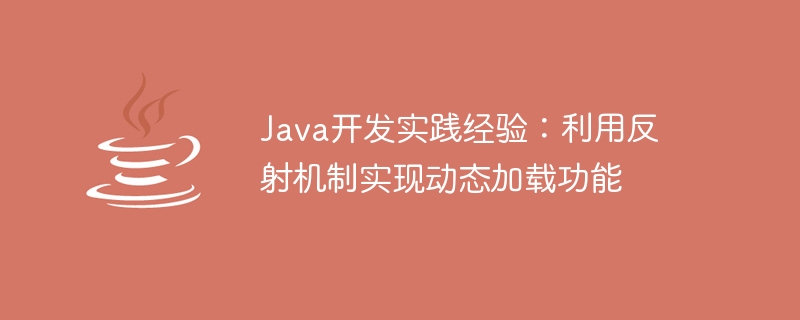

Practical experience in Java development: using reflection mechanism to implement dynamic loading function
Introduction:
In Java development, sometimes it is necessary to dynamically load some classes at runtime or modules to achieve more flexible and scalable functionality. Java provides a reflection mechanism that can obtain and operate class information at runtime. Dynamic loading can be achieved through reflection. This article will introduce the practical experience of how to use the reflection mechanism to achieve dynamic loading.
1. Overview of reflection mechanism:
Reflection is a feature of Java that allows programs to obtain and operate class information at runtime. In Java, a class is a special object that can be obtained and manipulated through reflection. The reflection mechanism allows us to obtain information such as properties, methods, and constructors of a class at runtime, and can dynamically use this information to create objects, call methods, etc.
2. Requirements for dynamic loading:
In some scenarios, we need to decide which classes or modules to load at runtime based on user input or configuration. For example, we may need to dynamically load different plug-ins or modules to extend the functionality of the program based on the user's selection. At this time, the reflection mechanism can help us realize the dynamic loading function.
3. Practical experience:
Obtain the Class object of the class:
First, we need to obtain the Class object of the class through reflection. In Java, you can obtain the Class object of a certain class through the Class.forName() method. This method accepts a fully qualified class name as a parameter and returns the corresponding Class object. For example, to obtain the Class object of the class named "com.example.MyClass", you can use the following code:
Class clazz = Class.forName("com.example.MyClass");Create the object:
After obtaining the Class object, we Objects can be created using the newInstance() method. An example is as follows:
Object obj = clazz.newInstance();
This way you can dynamically create an object of a class.
Calling methods:
The reflection mechanism also allows us to call class methods at runtime. First, we need to get the Method object of the method. The Method object of a specific method can be obtained through the getMethod() method provided by the Class class, for example:
Method method = clazz.getMethod("methodName", parameterTypes);where "methodName" is the method name and parameterTypes is the parameter type array. After obtaining the Method object, you can call the method by calling the invoke() method. The sample code is as follows:
method.invoke(obj, args);
Among them, obj is the object of the method call, and args is the parameters required by the method.
Summary:
By using Java's reflection mechanism, we can dynamically load classes, create objects, call methods, etc. at runtime to achieve more flexible and scalable functions. In actual development, we can combine technologies such as reflection and configuration files to achieve plug-in, modularization and other needs, and improve the flexibility and scalability of the program. However, the reflection mechanism needs to be used with caution, as improper use may lead to performance issues and security risks. Therefore, sufficient testing and security considerations are required when using reflection to ensure the stability and security of the program.
References:
[1] Oracle. Java Reflection - The Basics. https://docs.oracle.com/en/java/javase/11/docs/api/java.base/java /lang/reflect/package-summary.html. Accessed October 20, 2021.
[2] GeeksforGeeks. Java Reflection – Overview. https://www.geeksforgeeks.org/reflection-in-java/. Accessed October 20 , 2021.
The above is the detailed content of Practical experience in Java development: using reflection mechanism to implement dynamic loading function. For more information, please follow other related articles on the PHP Chinese website!
